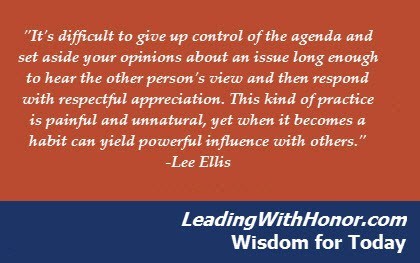Lee Ellis's Blog, page 329
August 25, 2014
Here’s a Frequently Asked Leadership Question from Young, Next Generation Leaders
Here’s a Frequently Asked Leadership Question from young, next generation leaders –
Question –
“During your POW experience, your leadership training came as much from watching others as reflecting on your own experience?”
Answer –
“Yes. I’m watching different styles of leadership, as a junior-ranking guy, and watching how different people respond in different ways. They say values are more caught than taught – I was just catching certain mindsets about leadership that were very important.
You couldn’t pretend there, for instance. Whatever was there was real. Whatever you said, you were going to be put to the test.
Seeing that, and seeing the sacrifice, I said as a leader I must be willing to do the very best you can, but I also have to be willing to sacrifice and not be afraid.
I’ve always wanted to be a leader. I’ve always wanted to be in charge. In the POW camp, I wasn’t, so I was always thinking. I learned a lot by watching these guys and how they did it. In the Air Force, I was a leader for most of my career after I got back. I had a chance to put some of this stuff to the test, and I found it worked – not because I was the smartest guy in the room, but because I had good leadership and was surrounded by good people.”
Click Here to learn more about Lee’s POW experience and the leadership lessons that he learned there.


August 24, 2014
Leadership on This Day in History – “The Communist Control Act”
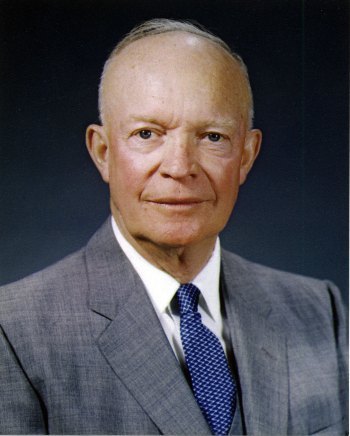 On this Day in History, President Eisenhower signs the “Communist Control Act” in 1954. Its purpose is outlaw the Communist Party and anyone sympathizing or participating with Communist ideology from serving in public service in the United States of America.
On this Day in History, President Eisenhower signs the “Communist Control Act” in 1954. Its purpose is outlaw the Communist Party and anyone sympathizing or participating with Communist ideology from serving in public service in the United States of America.
The Act was one of many bills drafted with the intention of protecting America from the potential threat posed by the international Communists. During this time, some argued that “the pursuit of subversive aims even by peaceful means should [have been] outlawed.” Thus, many opposed Communism because of its supposed “subversive aim” to undermine democracy. In the words of the prominent sociologist Ernest van den Haag, there was “no place in democracy for those who want[ed] to abolish [it] even with a peaceful vote.”
We’re grateful for this intentional step to preserve the democracy and freedom of America.


August 23, 2014
Identifying Your Unique Leadership Strengths and Struggles – Free Offer
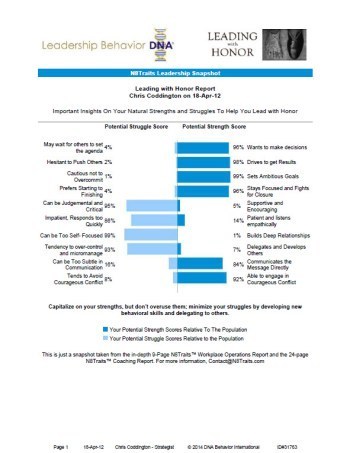 People are learning more about their natural behaviors and tendencies in leadership. What’s your unique strengths and struggles?
People are learning more about their natural behaviors and tendencies in leadership. What’s your unique strengths and struggles?
Satisfy your curiosity, and get a free snapshot with the Leading with Honor Assessment. It’s our gift to you, and please share!
Click here to get started.
What Others Are Saying -
“We have used the Leadership Behavior DNA assessment for over 5 years now and find the reports very insightful. We screen all potential employees and use the results to determine if the candidate would fit the job role and our company culture. In addition to the hiring process, we use the tool to help our team understand how they can communicate with other associates more effectively.”
- Shaun Callahan, President, Georgia Fluid System Technologies


August 22, 2014
Lee Ellis – Wisdom for Today, August 22, 2014
“It’s difficult to give up control of the agenda and set aside your opinions about an issue long enough to hear the other person’s view and then respond with respectful appreciation. This kind of practice is painful and unnatural, yet when it becomes a habit can yield powerful influence with others.”
-Lee Ellis


August 21, 2014
The Latest Recommendation from Lee’s Bookshelf – “Primal Leadership” by Daniel Goleman, Richard E. Boyatzis, and Annie McKee
 The Latest Recommendation from Lee’s Bookshelf – “Primal Leadership” by Daniel Goleman, Richard E. Boyatzis, and Annie McKee
The Latest Recommendation from Lee’s Bookshelf – “Primal Leadership” by Daniel Goleman, Richard E. Boyatzis, and Annie McKee
Here’s a brief summary of this insightful leadership resource – “Unveiling neuroscientific links between organizational success or failure and ‘primal leadership,’ the authors argue that a leader’s emotions are contagious. If a leader resonates energy and enthusiasm, an organization thrives; if a leader spreads negativity and dissonance, it flounders. This breakthrough concept charges leaders with driving emotions in the right direction to have a positive impact on earnings or strategy.”
Click here to read more on Good Reads.
Have you read this book? If so, please share your comments -


New Article! Lee’s Return to Vietnam as a Former POW and Leadership Lessons Learned

Over 40 years after Lee’s release as a prisoner of war in Vietnam, he returned to remember and honor the senior leaders that enabled he and his comrades to return with honor.
Just Released! An in-depth article on Lee’s return the POW camp in Vietnam – here’s an excerpt –
“Ellis, usually a model of reserve, started to look a little apprehensive as he walked in, and he was immediately frustrated by Vietnam’s rigid officialdom: a cameraman he brought from the cruise ship can’t bring in his professional-level gear because he didn’t seek government permission first. Still cameras and cell phone cameras were OK, though.
As it turned out, one of the remaining sections of the prison is where Ellis was held. It was dubbed ‘Thunderbird,’ after the former Las Vegas hotel, as were other sections: ‘Desert Inn’ and ‘Stardust.’ Bare light bulbs provided scant light. Two rows of statues depicted shackled Vietnamese prisoners — the museum is dedicated to them; the American POWs are treated almost as an afterthought.”
Click here to continue reading the article, and please share it with others.
Related Articles:
The Power of One Person’s Commitment – A POW Bracelet Testimony
Leader and Gen. Robinson Risner Rose To Torturous Challenge As POW


August 20, 2014
New Speaking Clip – Shoot Down and Capture, Imaginary Monkey and Motorcycles, and More
Shoot down and capture, imaginary monkeys and motorcycles, and more – check out the latest short speaking clip from Lee as he delivers his keynote address.
Please watch and share!
Related Articles:
4 Leadership Vitamins to Take for Low Emotional Intelligence
Freeing the Captives—How to Confront Your Personal Leadership Barriers


Show Your Support of Courage and Character in Leadership!
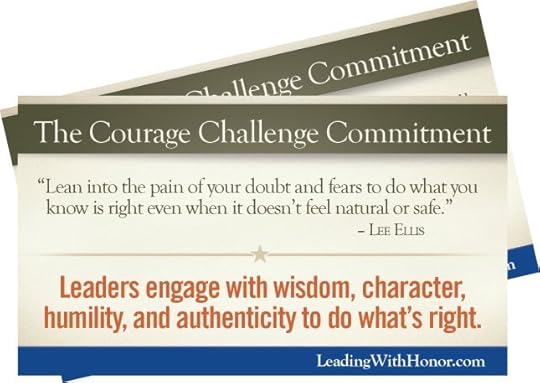
Along with the Courage Challenge Card pictured above, many other items are available to help keep honorable leadership as a daily reminder in your work.
Keep a daily reminder of how to lead with character, courage, and competence – Leading with Honor items such as reminder cards, wristbands, and courage challenge cards are available in our Online Store.
Great for the corporate boardroom or next generation teaching in school or community clubs and classrooms.
Visit our Online Store for more details
August 19, 2014
How Assessment Tools Clarify Leadership Risk and Growth
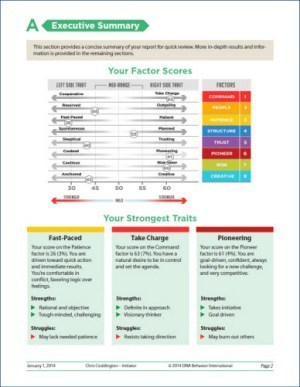
This is a screenshot of a page from the upcoming new report from Leadership Behavior DNA, an assessment created by Lee Ellis.
By Lee Ellis
Carla, Senior Vice-President of a Fortune 200 company, has the challenge of evaluating the natural leadership potential of several team members. She had worked with all of them for some time, but she’s unsure about the best criteria to match the needed skills for the job with the potential candidates. Not only does she want the person in the right role, but she needs someone that can produce results, increase productivity, and manage a cohesive team. Knowing that 62% of executive decisions are made based solely on gut feelings*, she wants to make a better hiring decision by obtaining more concrete data about each candidate.
Where Does She Start?
With over 30 years of research and experience in the fields of human behavior and performance, I believe that it’s unequivocally true that every person is unique and that all leaders (and the people they manage) have different talents. Here are some other confirmations:
The best leaders have a mix of natural and learned behaviors.
You can confirm that an individual belongs in a specific personality style, but the style categorization should not be used to put people in a “box”.
There are no good or bad personality styles to determine leadership ability—just different. Great leaders come from all styles.
“So, it’s important to be objective and realize that anyone can become a successful leader.”
Results vs. Relationships Evaluated
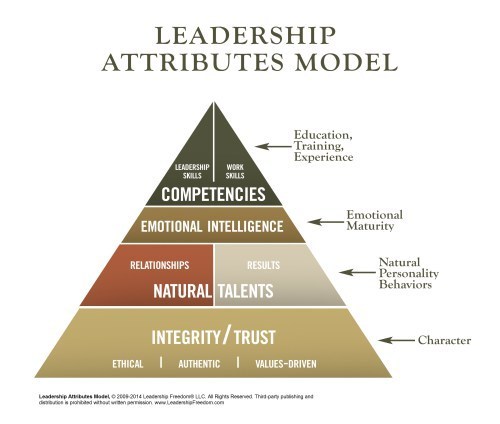 After evaluating that the base character and integrity of each candidate matches the values of the company, the next step is evaluating their results vs. relationships balance.
After evaluating that the base character and integrity of each candidate matches the values of the company, the next step is evaluating their results vs. relationships balance.
We’ve all been there and worked for the leader that got results but had no trusted relationships on their team. They were simply a machine that met the desired goals at any cost. On the flip side, there were the “fun leaders” that wasted hours every day talking and socializing with the team and then scrambled at the last minute to get a few things accomplished. They’re fun to be around, but results and progress ultimately fall short on a regular basis.
“Statistically, 40% of leaders are more results (mission) oriented, and 40% are more relationships (people) oriented.”
The most effective leaders have balanced skills in both results and relationships. For example, a successful leader must be tough or soft as the situation dictates. Even though some leaders are naturally either tough or soft, that’s where our learned behaviors come into play to be truly successful.
Communication Style Analyzed
Another key area to evaluate is communication style when interacting with others. Think of the people on your own team or department and how different they are. While the goal is treat everyone fairly, a successful leader understands the unique differences in people and communicates with them differently.
Some people will need more interaction with their manager than others in order to do a good job, while others are more self-managing. Some people work best when they can more on tasks, while others will work better when their work involves more frequent interaction with others. The communication needs with these team members are different, too.
Successful leaders also need the courage do to the hard things such as confronting poor performance and bad behavior. It also takes courage for some leaders to do the soft things such as encouraging and supporting their people. Healthy accountability is critical to maintain standards and values, and that’s easier for some leaders to do than others.
“All of these examples hinge on the leader’s natural and/or learned ability to communicate in different ways with different people.”
The Next Step in Assessing Leaders
While other natural competencies such as problem-solving skills, decision-making skills, and support needed should also be considered, validating the key skills above is a wise endeavor.
To help with Carla’s hiring process, asking the right questions and using an assessment tool** for each candidate will give her greater chances for success as she builds her team. With this newfound data, she can choose a leader that has the character, courage, and the talent balance to propel the company forward and support a culture of great leadership.
LE
“An honorable leader must demonstrate a willingness to reveal his or her ‘inner self’ to their team. It builds trust and trust is essential. It’s also a sign of strength and authenticity, and people are attracted to those who are ‘real’ and authentic.” – Lee Ellis
*Source: http://www.gyro.com/#/igniting-now/news/new-study-emotion-trumps-data-for-business-decision-makers/
**Click here to learn more about Leadership Behavior DNA, the best assessment tool available for evaluating natural leadership performance.
~~~~~
As president of Leadership Freedom® LLC, a leadership and team development consulting company, Lee Ellis consults with Fortune 500 senior executives in the areas of hiring, teambuilding, leadership and human performance development, and succession planning. Also a retired USAF Colonel, his latest book about his Vietnam POW experience is entitled Leading with Honor: Leadership Lessons from the Hanoi Hilton. Learn more at http://www.leadingwithhonor.com.


August 17, 2014
Giving Highlight – Yellow Ribbon Reintegration Program
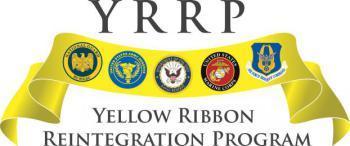 Lee Ellis and his publishing company, FreedomStar Media, proudly support the Yellow Ribbon Reintegration Program. Its mission is to provide quality Joint deployment support & reintegration services to all Service members and their Families enabling them to sustain the rigors associated with deployment or mobilization.
Lee Ellis and his publishing company, FreedomStar Media, proudly support the Yellow Ribbon Reintegration Program. Its mission is to provide quality Joint deployment support & reintegration services to all Service members and their Families enabling them to sustain the rigors associated with deployment or mobilization.
Lee speaks to hundreds of military officers and their families at these events every year. If you’re searching for an organization that directly supports military personnel and their families, learn more at the banner link below.



